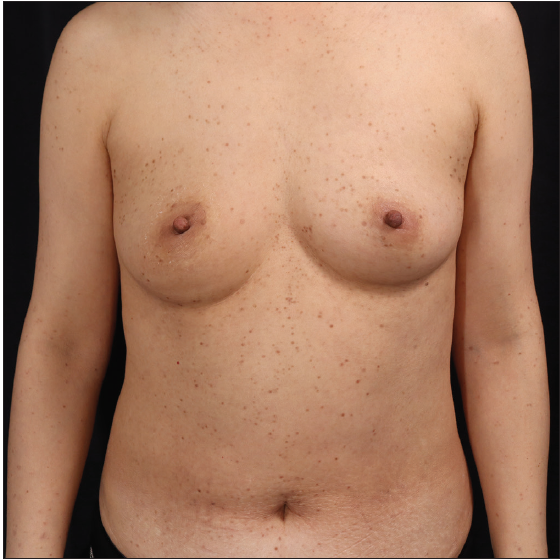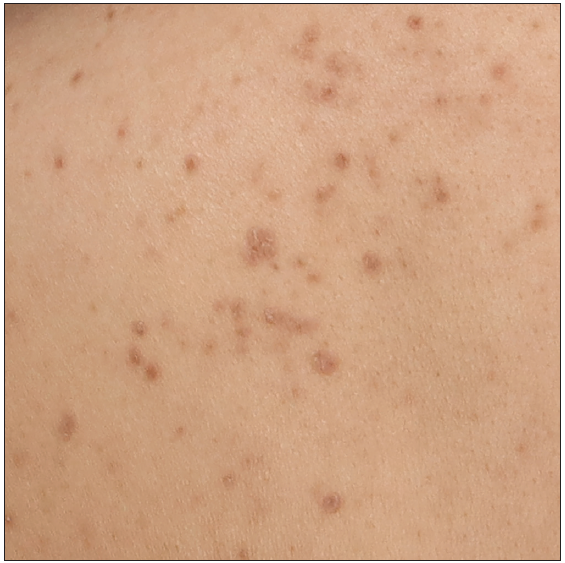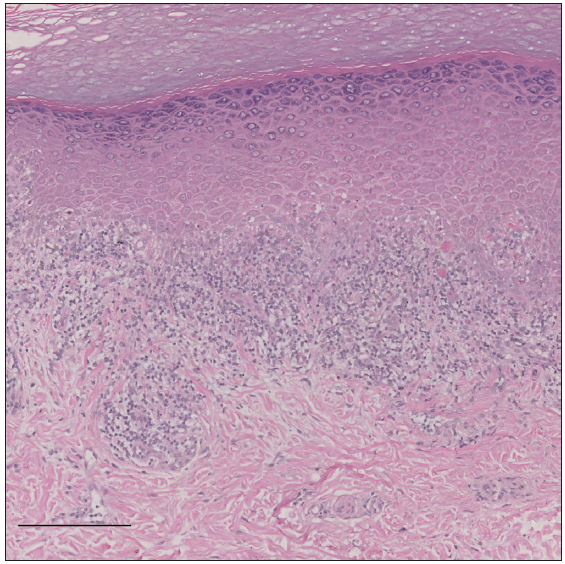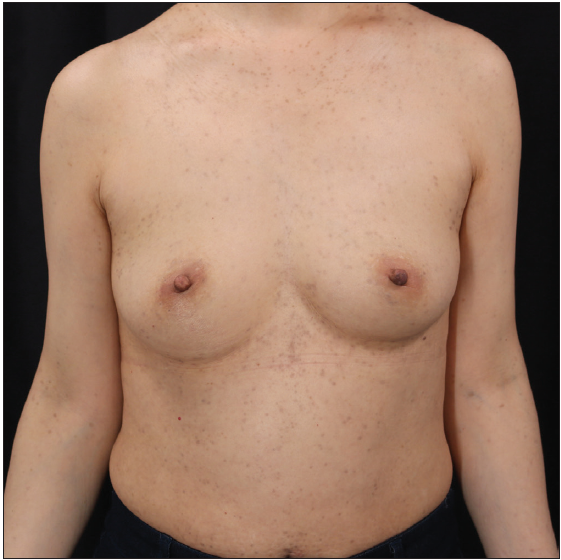Translate this page into:
Eruptive lichen planus treated with baricitinib: A case report
Corresponding author: Dr. Xingyuan Jiang, Department of Dermatology, Peking University First Hospital, Beijing, China. puhscjxy@bjmu.edu.cn
-
Received: ,
Accepted: ,
How to cite this article: Xue R, Jiang X. Eruptive lichen planus treated with baricitinib: A case report. Indian J Dermatol Venereol Leprol. doi: 10.25259/IJDVL_461_2023
Dear Editor,
Lichen planus (LP) is a chronic inflammatory skin disease characterised by violaceous, polygonal, pruritic, flat-topped papules or plaques with white lines on the surface known as Wickham striae. Systemic therapies are necessary for the management of generalised LP. Conventional medications include retinoids, corticosteroids, phototherapy and immunosuppressants such as methotrexate and cyclosporine.1 However, there are some cases which tend to be refractory to standard treatments.2 Therefore, a more effective and safer therapeutic approach is needed. In this report, we present a case of phototherapy-resistant eruptive LP, which showed remarkable response to treatment with baricitinib, a Janus kinase 1 and 2 (JAK1/2) inhibitor, which was well tolerated.
A 49-year-old woman reported skin rashes with pruritus on her shoulder and back for 3 months. Physical examination revealed multiple erythematous to brownish polygonal papules, 3~5 mm in diameter, which were symmetrically distributed on her trunk, upper extremities and dorsum of both hands [Figures 1a and 1b]. Asymptomatic reticular white patches were observed on her bilateral buccal mucosae. Histological analysis was notable for wedge-shaped thickening of the granular layer, liquefactive degeneration and band-like subepidermal lymphocytic infiltration. Colloid bodies were also seen [Figure 1c]. The patient was otherwise healthy and tested negative for hepatitis B and C antibodies. A diagnosis of eruptive LP was made. We used the Visual Analogue Scale (VAS) score to evaluate pruritus and the Lichen Planus Activity and Damage Index (LiPADI) to assess disease severity.3 At baseline, her VAS score was 4, with LiPADI scoring of 26.

- Multiple erythematous to brownish papules scattered on the trunk and upper extremities at baseline.

- Close up view of lesions at baseline.

- Histopathology demonstrating wedge-shaped thickening of the granular layer, liquefactive degeneration and band-like subepidermal lymphocytic infiltration with colloid bodies (Haematoxylin & Eosin, 100x, bar = 200 μm).
Three months of narrowband ultraviolet B (NB-UVB) therapy three times per week in combination with topical corticosteroids (Halometasone cream, 0.05%) and calcineurin inhibitor (Tacrolimus cream, 0.1%) provided only minimal relief to the patient’s symptoms, and the skin lesions continued to progress. As a result, the patient was considered resistant to phototherapy.4 Due to concerns about potential side effects, the patient declined oral steroids, immunosuppressants and acitretin. The patient was then treated with 4 mg baricitinib per day, which led to complete resolution of itching after 2 weeks. Over time, the patient’s VAS and LiPADI scores decreased significantly [Table 1]. Flattened papules and post-inflammatory hyperpigmentation were observed with no occurrence of new skin lesions [Figure 2]. After 20 weeks of continuous treatment with baricitinib, the patient experienced complete resolution of pruritus, further flattening of the papules and eventually hyperpigmentation. At the 30-week follow-up, there was no recurrence of skin lesions and no report of side effects.
| Week 0 | Week 6 | Week 12 | Week 20 | |
|---|---|---|---|---|
| VAS | 4 | 0 | 0 | 0 |
| LiPADI | 26 | 22 | 20 | 14 |

- Resolution of lesions with residual hyperpigmentation at week-20, following baricitinib treatment.
Lichen planus is an inflammatory disease that can affect the skin, nails and mucosae. Histologically, it is characterised by the presence of band-like infiltrates of lymphocytes primarily at the junction of dermis and epidermis, known as lichenoid infiltrate.5 While the immunopathogenesis of LP is not completely understood, there is increasing evidence suggesting that Janus kinase signal transducer and activator of transcription (JAK-STAT)-dependent cytokines, such as interferon (IFN)-γ, play a major role in the development and persistence of chronic inflammation of the disease.6 Activation of the JAK-STAT pathway in keratinocytes by IFN-γ enhances the anti-keratinocyte response of T cells in vitro.6 Janus kinases, particularly JAK1/2, play a crucial role in signalling the effects of IFN-γ, making baricitinib a promising therapeutic option for refractory LP.
Certain variants of LP, such as nail lichen planus, oral erosive lichen planus and lichen planopilaris are often treatment-resistant and recrudescent.6 The management of generalised LP is also challenging, with only 31–100% response rate to conventional treatments such as phototherapy.1 Recently, Janus kinase inhibitors (JAKi), such as baricitinib, tofacitinib and upadacitinib, have been suggested as potentially effective treatments for this disease.7 In our case of eruptive LP resistant to phototherapy, baricitinib demonstrated significant efficacy in rapidly relieving pruritus and improving skin lesions. Furthermore, we postulate that systemic and topical JAKi may have broad applications in the treatment of LP and lichenoid dermatoses, including lichen nitidus, lichen sclerosus and lichen striatus, which share some similar histologic or immunologic features with lichen planus.5
Declaration of patient consent
The authors certify they have obtained all appropriate patient consent.
Financial support and sponsorship
Nil.
Conflicts of interest
There are no conflicts of interest.
Use of artificial intelligence (AI)–assisted technology for manuscript preparation
The authors confirm that there was no use of artificial intelligence (AI)–assisted technology for assistance in writing or editing of the manuscript, and no images were manipulated using AI.
References
- Effectiveness of narrowband UVB phototherapy and psoralen plus UVA photochemotherapy in the treatment of generalized lichen planus: Results from a large retrospective analysis and an update of the literature. Photodermatol Photoimmunol Photomed. 2022;38:104-11.
- [CrossRef] [PubMed] [PubMed Central] [Google Scholar]
- Efficacy and safety of oral methotrexate versus oral mini pulse betamethasone therapy in the treatment of lichen planus: A comparative study. J Dermatolog Treat. 2022;33:3039-46.
- [CrossRef] [PubMed] [Google Scholar]
- Lichen planus activity and damage index (LiPADI)-creation of the questionnaire. J Clin Med. 2021;11:23.
- [Google Scholar]
- Narrow band ultraviolet B for the treatment of generalized lichen planus. Cutan Ocul Toxicol. 2016;35:190-3.
- [CrossRef] [PubMed] [Google Scholar]
- Lichen planus and lichenoid dermatoses: Clinical overview and molecular basis. J Am Acad Dermatol. 2018;79:789-804.
- [CrossRef] [PubMed] [Google Scholar]
- JAK inhibitors in lichen planus: A review of pathogenesis and treatments. J Dermatolog Treat. 2022;33:3098-103.
- [CrossRef] [PubMed] [Google Scholar]
- The use of Janus kinase inhibitors for lichen planus: An evidence-based review. J Cutan Med Surg. 2023;27:271-6.
- [CrossRef] [PubMed] [PubMed Central] [Google Scholar]






